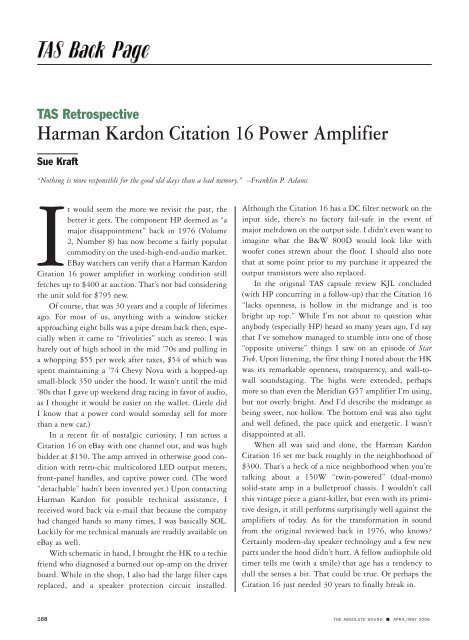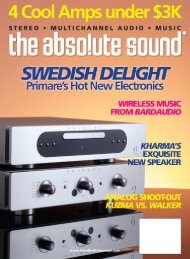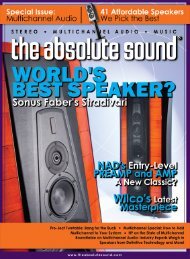in this issue
in this issue
in this issue
Create successful ePaper yourself
Turn your PDF publications into a flip-book with our unique Google optimized e-Paper software.
TAS Retrospective<br />
Harman Kardon Citation 16 Power Amplifier<br />
Sue Kraft<br />
“Noth<strong>in</strong>g is more responsible for the good old days than a bad memory.” –Frankl<strong>in</strong> P. Adams<br />
It would seem the more we revisit the past, the<br />
better it gets. The component HP deemed as “a<br />
major disappo<strong>in</strong>tment” back <strong>in</strong> 1976 (Volume<br />
2, Number 8) has now become a fairly popular<br />
commodity on the used-high-end-audio market.<br />
EBay watchers can verify that a Harman Kardon<br />
Citation 16 power amplifier <strong>in</strong> work<strong>in</strong>g condition still<br />
fetches up to $400 at auction. That’s not bad consider<strong>in</strong>g<br />
the unit sold for $795 new.<br />
Of course, that was 30 years and a couple of lifetimes<br />
ago. For most of us, anyth<strong>in</strong>g with a w<strong>in</strong>dow sticker<br />
approach<strong>in</strong>g eight bills was a pipe dream back then, especially<br />
when it came to “frivolities” such as stereo. I was<br />
barely out of high school <strong>in</strong> the mid ’70s and pull<strong>in</strong>g <strong>in</strong><br />
a whopp<strong>in</strong>g $55 per week after taxes, $54 of which was<br />
spent ma<strong>in</strong>ta<strong>in</strong><strong>in</strong>g a ’74 Chevy Nova with a hopped-up<br />
small-block 350 under the hood. It wasn’t until the mid<br />
’80s that I gave up weekend drag rac<strong>in</strong>g <strong>in</strong> favor of audio,<br />
as I thought it would be easier on the wallet. (Little did<br />
I know that a power cord would someday sell for more<br />
than a new car.)<br />
In a recent fit of nostalgic curiosity, I ran across a<br />
Citation 16 on eBay with one channel out, and was high<br />
bidder at $150. The amp arrived <strong>in</strong> otherwise good condition<br />
with retro-chic multicolored LED output meters,<br />
front-panel handles, and captive power cord. (The word<br />
“detachable” hadn’t been <strong>in</strong>vented yet.) Upon contact<strong>in</strong>g<br />
Harman Kardon for possible technical assistance, I<br />
received word back via e-mail that because the company<br />
had changed hands so many times, I was basically SOL.<br />
Luckily for me technical manuals are readily available on<br />
eBay as well.<br />
With schematic <strong>in</strong> hand, I brought the HK to a techie<br />
friend who diagnosed a burned out op-amp on the driver<br />
board. While <strong>in</strong> the shop, I also had the large filter caps<br />
replaced, and a speaker protection circuit <strong>in</strong>stalled.<br />
Although the Citation 16 has a DC filter network on the<br />
<strong>in</strong>put side, there’s no factory fail-safe <strong>in</strong> the event of<br />
major meltdown on the output side. I didn’t even want to<br />
imag<strong>in</strong>e what the B&W 800D would look like with<br />
woofer cones strewn about the floor. I should also note<br />
that at some po<strong>in</strong>t prior to my purchase it appeared the<br />
output transistors were also replaced.<br />
In the orig<strong>in</strong>al TAS capsule review KJL concluded<br />
(with HP concurr<strong>in</strong>g <strong>in</strong> a follow-up) that the Citation 16<br />
“lacks openness, is hollow <strong>in</strong> the midrange and is too<br />
bright up top.” While I’m not about to question what<br />
anybody (especially HP) heard so many years ago, I’d say<br />
that I’ve somehow managed to stumble <strong>in</strong>to one of those<br />
“opposite universe” th<strong>in</strong>gs I saw on an episode of Star<br />
Trek. Upon listen<strong>in</strong>g, the first th<strong>in</strong>g I noted about the HK<br />
was its remarkable openness, transparency, and wall-towall<br />
soundstag<strong>in</strong>g. The highs were extended, perhaps<br />
more so than even the Meridian G57 amplifier I’m us<strong>in</strong>g,<br />
but not overly bright. And I’d describe the midrange as<br />
be<strong>in</strong>g sweet, not hollow. The bottom end was also tight<br />
and well def<strong>in</strong>ed, the pace quick and energetic. I wasn’t<br />
disappo<strong>in</strong>ted at all.<br />
When all was said and done, the Harman Kardon<br />
Citation 16 set me back roughly <strong>in</strong> the neighborhood of<br />
$300. That’s a heck of a nice neighborhood when you’re<br />
talk<strong>in</strong>g about a 150W “tw<strong>in</strong>-powered” (dual-mono)<br />
solid-state amp <strong>in</strong> a bulletproof chassis. I wouldn’t call<br />
<strong>this</strong> v<strong>in</strong>tage piece a giant-killer, but even with its primitive<br />
design, it still performs surpris<strong>in</strong>gly well aga<strong>in</strong>st the<br />
amplifiers of today. As for the transformation <strong>in</strong> sound<br />
from the orig<strong>in</strong>al reviewed back <strong>in</strong> 1976, who knows?<br />
Certa<strong>in</strong>ly modern-day speaker technology and a few new<br />
parts under the hood didn’t hurt. A fellow audiophile old<br />
timer tells me (with a smile) that age has a tendency to<br />
dull the senses a bit. That could be true. Or perhaps the<br />
Citation 16 just needed 30 years to f<strong>in</strong>ally break <strong>in</strong>.<br />
168 THE ABSOLUTE SOUND ■ APRIL/MAY 2006










